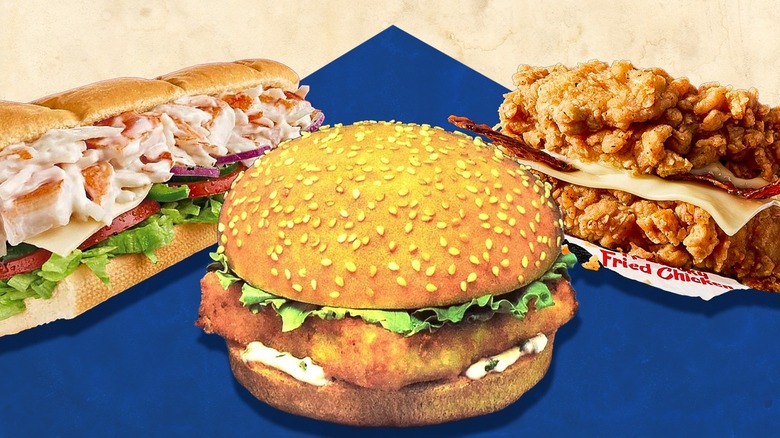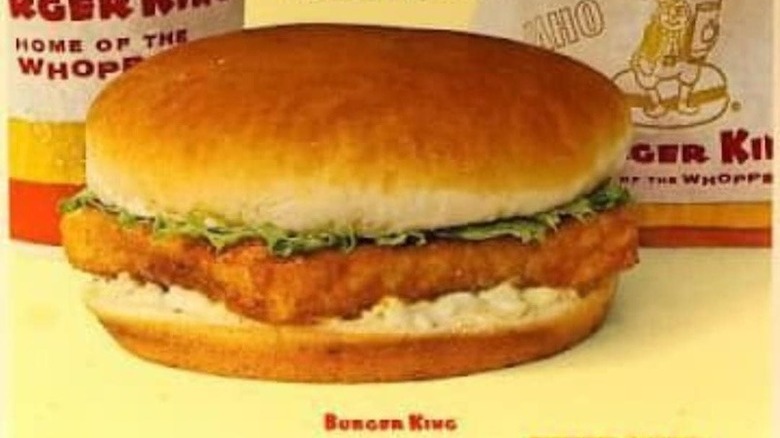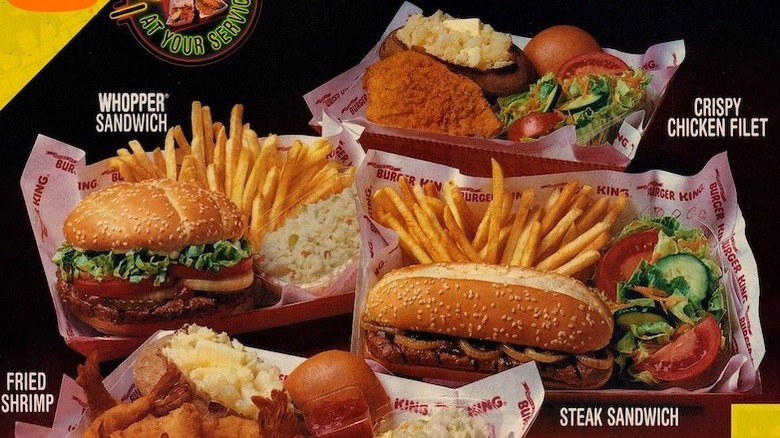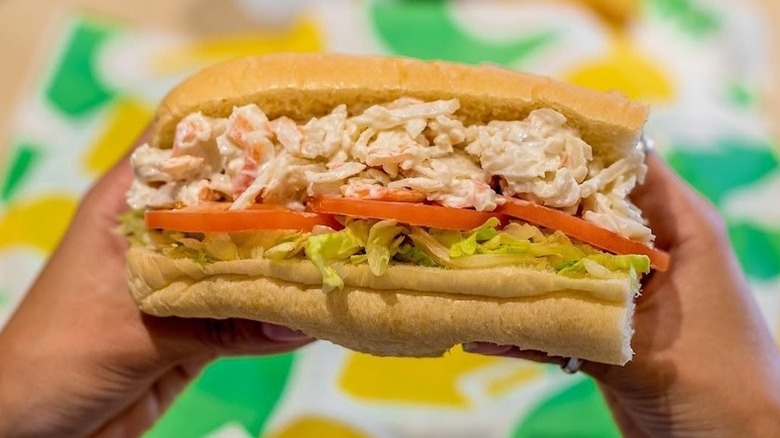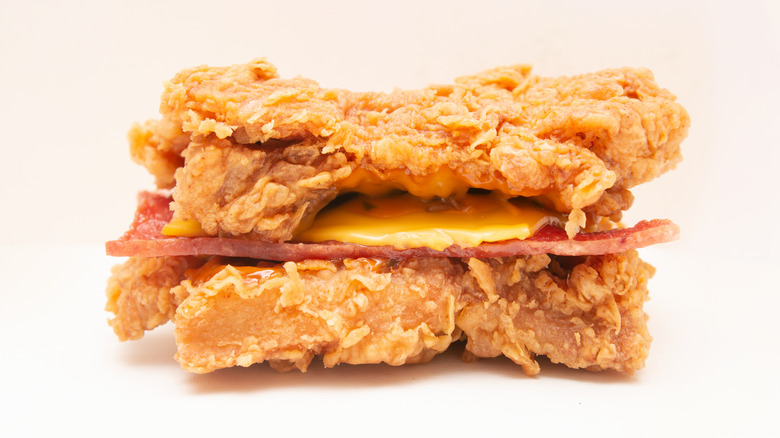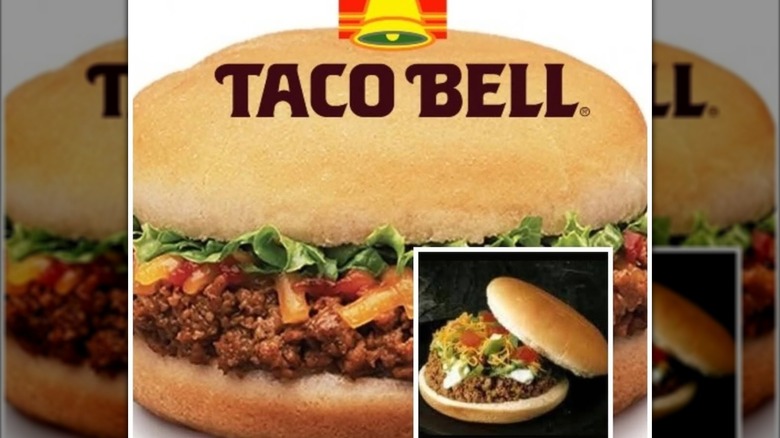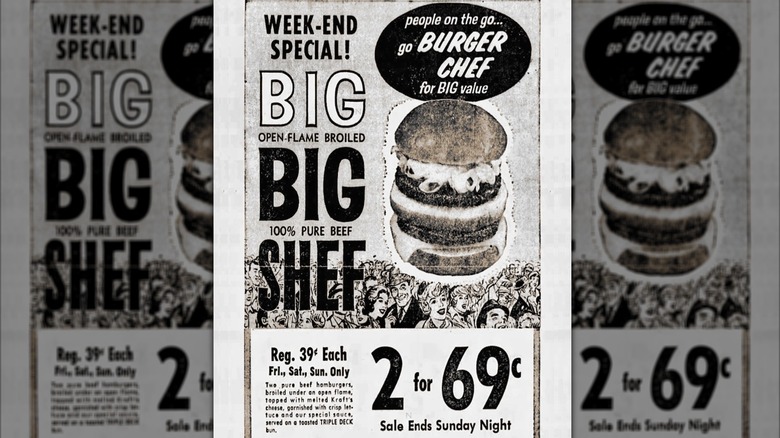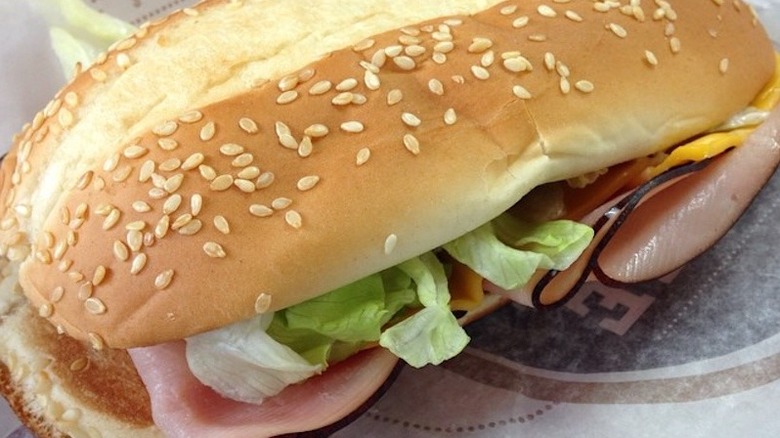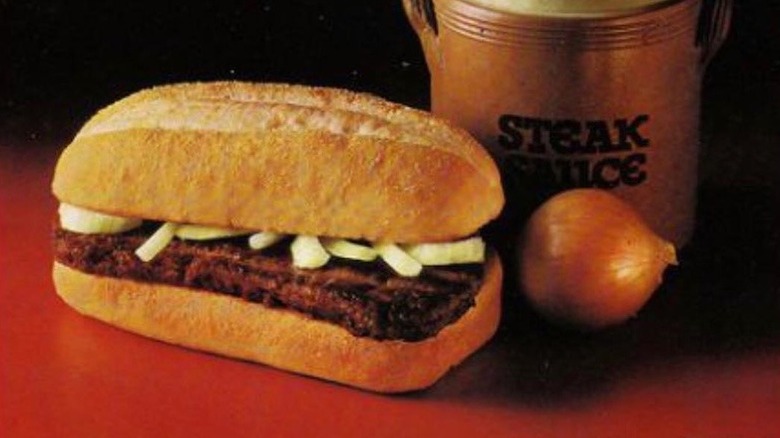Old-School Fast Food Sandwiches That Disappeared
While they're known by all sorts of ear-catching names like sub, grinder, Double Stack, Big Mac, Jumbo Jack, Double Double, and Club, make no mistake: Those tall and tantalizing towers of protein, cheese, and veggies are just sandwiches. One of the simplest, most delicious, and open-ended creations in the realm of food, the sandwich has served as the foundation of American-style fast food for the last near-century or so. A hoagie is a sandwich, a burger is a sandwich, and a fried boneless patty of chicken or fish placed on a bun is a sandwich.
Sandwiches are where fast food conglomerates shine. With amazing regularity over the decades, every major chain has introduced dozens of new sandwiches, earning new fans and customers and pushing fast food forward in the process. Or, those sandwiches are sometimes a bit too weird and ambitious and became famous for all the wrong reasons. Eventually, it would seem, all but a few stalwarts ultimately exit fast food menus, leaving the general public to wonder what exactly went wrong. Here are the vintage fast food sandwiches that came and went, both the beloved and the notorious, but which all made an impression decades ago and are still remembered, for better or for worse.
The Whaler — Burger King
The 1970s were a time of experimentation and expansion in fast food, which meant the rise of fish-focused operations like Arthur Treacher's Fish and Chips and Long John SIlver's. The already established chains added fish sandwiches to their menu, led by McDonald's with its still-available and relatively unchanged Filet-O-Fish, and Burger King's grandly but inaccurately named the Whaler. It wasn't made with whale meat, but as of 1971, the standard mild and meaty whitefish in the form of a patty, breaded and fried until crisp placed in a bun with lettuce and tartar sauce added. The Whaler wasn't a massive hit, however, and it failed to earn a permanent spot on Burger King's national menu.
In 1983, Burger King tried out the Whaler again, using the fish sandwich as a pawn in a marketing war with McDonald's, touting how it was better than the Filet-O-Fish and citing in ads how the item was bigger than the better-known sandwich and as big as a burger. Once more, the Whaler didn't gain traction, and while Burger King kept it around, it retooled it on multiple occasions. At one point, Burger King brought in a new bun and breading material and called the new sandwich the Ocean Catch, followed by a newer formulation and another rebrand as the Big Fish. Burger King's Big Fish is made with a more premium fish, wild pollock, that's breaded in panko, and it's a long way from the Whaler of the '70s.
Steak Sandwich — Burger King
In the early 1990s, Burger King tried to class itself up by transforming itself into more of a sit-down restaurant. Between the hours of 4 p.m. to 8 p.m., Burger King employees would bring food directly to customers' tables, where they'd be waiting while munching on a free popcorn appetizer. The program was focused around dinner baskets, which included a roll, a choice of tossed salad or coleslaw, french fries or a baked potato, and one of four entrees: a Whopper, fried shrimp, a boneless and breaded chicken patty, or a brand-new Steak Sandwich. What was really a gussied-up hamburger was made up of a chopped and formed beef patty placed inside of a long, sesame-seed-studded bun and topped with generous amounts of steak sauce and raw onions.
Table service and dinner baskets only lasted from 1992 to 1994, but it was a radical departure from the normal business operations for a fast food burger joint. At that point, the Burger King Steak Sandwich was dropped from the menu entirely, as was the similar, more obscure regional offering of a meatloaf sandwich.
Seafood Sensation — Subway
Most every major sandwich chain serves tuna salad, some better than others, including Subway. During the 2020s, the sub company was sued for allegedly serving up a mix of various proteins and inaccurately calling it tuna, but for decades, fish was enough of a seller for Subway to offer additional salad-type sandwiches made with meat obtained from the ocean. Around the early 1980s, Subway locations sold a Seafood and Crab sandwich, and in the 1990s, it added the Seafood and Lobster sandwich to its line of cold subs. The latter didn't stick around for long, but the redundantly titled Seafood and Crab remained a fixture into the 21st century, albeit as the more appetizing sounding Seafood Sensation. The chain's recipe for that sandwich was chunks of unidentified seafood mixed with reduced-calorie mayonnaise, and then plopped onto a 6-inch or footlong loaf of bread.
Subway actually used imitation crab meat in the Seafood Sensation. What's really in imitation crab? It's a processed food product made from a little bit of snow crab but mostly other inexpensive ingredients that approximate real shellfish, such as pollock, Pacific Whiting, cornstarch, potato starch, egg whites, and a number of food-grade chemicals. The Seafood Sensation is no longer available at stateside Subway stores, but a sandwich made with pretend crab can be obtained at the chain's shops in the U.S. Virgin Islands and Australia.
The Double Down — KFC
It looked more like a publicity stunt or an April Fool's Day joke when KFC debuted one of its oddest menu items of all time. On April 1, 2010, the venerable chain generally responsible for old-fashioned fried chicken and homestyle meals introduced the Double Down. Not technically a sandwich because its construction didn't require two pieces of bread, but resembling a sandwich nonetheless, the Double Down's inside was a gloopy, fatty mixture of bacon, cheese, and proprietary KFC sauce. The outside: no bread or buns, but rather two breaded boneless fried chicken filets.
So named because it required a KFC cook to place two pieces of chicken in a fryer, the Double Down was derided by nutritionists and health advocacy groups. While the Double Down was extremely low in carbohydrates, it contained 32 grams of fat and 1,380 milligrams of sodium — about half the USDA-advised daily limit for the former, and 60% of the one-day recommendation for the latter. Nevertheless, the Double Down was a smash hit, with more than 10 million sandwiches purchased. That was below KFC's expectations, however, and it discontinued the Double Down, only to revive it for a short period of time in 2023.
Hula Burger — McDonald's
Cincinnati has historically been home to a large Roman Catholic population, and in 1962, local McDonald's franchisee Lou Groen noticed the major drop-off in business he experienced on Fridays in the spring. That coincided with Lent, the 40-day period of fasting and religious reflection leading up to Easter that Catholics observed in part by avoiding most meats except for fish on Fridays. To prevent any more bad-for-business drop-offs, Groen petitioned McDonald's boss Ray Kroc to put a Catholic-friendly sandwich on the menu to bring in Friday customers again. He suggested a whitefish patty, breaded and fried, placed in a hamburger bun.
Kroc agreed with Groen's idea, but not the execution. Theorizing that it would be tough for the average McDonald's kitchen to cook up mass amounts of fried fish sandwiches, he counter-suggested another meat-free sandwich that required very little prep work: The Hula Burger. It was a fruit and cheese combo, with a slice of American cheese resting atop a hunk of briefly grilled pineapple, inside of a standard bun. Kroc was so sure that his idea was better than Groen's that he arranged a test at the latter's Cincinnati franchise: For one Friday in Lent, that location would sell both sandwiches, and the one that sold the most would head to McDonald's national menu. The company chairman made good on his promise, introducing Groen's Filet-O-Fish company-wide in 1965, after it outsold the McDonald's Hula Burger by a count of 350 to six.
The Bell Beefer — Taco Bell
Mexican, Mexican-inspired, and Tex-Mex-style foods have been so incorporated into the American diet that foods like tacos and burritos are ordinary if not mundane, particularly if they're the kind sold by middle-of-the-road fast food purveyors like Taco Bell. Debuting in Southern California in 1962, Taco Bell was quickly franchised and did a lot of the work in familiarizing and popularizing Mexican food across the United States. In its early days, the chain took a patient and educational approach, explaining to its likely unfamiliar customers exactly what it was offering. The simple menu of about a half dozen items included pronunciation instructions and full product descriptions for what were then exotic treats like the tostada, burrito, frijoles, taco, and tostada.
But if all that was still a step too far into new terrain for a Taco Bell newbie, they had the Bellburger to fall back on. It resembled an omnipresent and familiar hamburger, but was created with Mexican flavors. Lettuce, onions, and a lightly spicy sauced topped a helping of Taco Bell's beef taco filling, and it all went onto a bun. It was essentially a Mexican-style sloppy joe, a once-popular sandwich people don't eat anymore. Called the Chili Burger in the 1960s, the Bellburger was renamed once more, going by the Bell Beefer from 1977 on. As customers started going to Taco Bell specifically for the Mexican food, the Bell Beefer fell off in popularity and was discontinued by the mid-1990s.
Arch Deluxe — McDonald's
Despite dominating the entire fast food industry for decades, McDonald's became very concerned in the 1990s that its food was perceived as simple, juvenile, and just for kids, what with their unrefined tastes. Seeking to capture a seemingly elusive demographic of adults, McDonald's created the Arch Deluxe in 1996, pitched as an elegant, fancy burger for people with refined taste who might otherwise not set foot in a McDonald's.
Essentially a pub burger, the Arch Deluxe was a basic sandwich but elevated, with a substantially well seasoned beef patty sharing space on a bakery bun with sliced onions, cheese, lettuce, tomato, a bacon round, and a brand-new pepper-mayonnaise sauce concocted just for the Arch Deluxe. McDonald's spent $200 million to get the word out about its just-for-adults burger with print and TV ads showing children repulsed by the sandwich — the logic being that grown-ups would definitely enjoy something like that. The year 1996 was also when the "Macarena" hit, and McDonald's promoted the Arch Deluxe-adjacent "Deluxe Line Dance" routine at public events.
None of those innovative marketing techniques worked, and by 1998, the Arch Deluxe phase-out began. McDonald's continues to attract hordes of voting age and above customers to its thousands of outlets, despite not selling the Arch Deluxe since 2000.
Big Shef — Burger Chef
As of 1972, Burger Chef had only been in business for 14 years and had already grown to become the second-largest fast food chain in the United States. It operated 1,200 outlets, behind only the 1,600-unit McDonald's. Not only was the Indiana-based Burger Chef popular, but it was a fast food innovator, too. It was the first to use a flame broiler (predating Burger King) and the first to offer a combo with kid-size portions and a free toy, the Fun Meal. That predated McDonald's Happy Meal, and Burger Chef's signature sandwich also arrived before the competition's flagship burger. In 1965, Burger Chef started making the Big Shef. One of the biggest burgers ever seen in fast food to that point, the Big Shef was a triple-decker affair that involved three bun pieces, two beef patties, cheese, lettuce, and a specially formulated sauce. The Big Shef beat the very similar Big Mac to the market by two years.
After falling to a network of just around 600 restaurants by 1982, Burger Chef was sold to and absorbed by Hardee's. The last Burger Chef to keep its branding did so until 1996. When Burger Chef vanished, so too did the Big Shef. Hardee's kept control of Burger Chef's trademarks, including the Big Shef, and it has revived the burger on a limited-time basis in Midwestern cities in 2001, 2007, and 2014.
Yumbo — Burger King
Back in 1968, Burger King made moves into non-beef territory with the introduction of the Yumbo Sandwich. A viable hamburger alternative and also a classic comfort food, the Yumbo was a hot ham and cheese sandwich, with the meat sliced thin and the cheese served melty and gooey, all of it on a warm roll. A cult favorite in its time, the Yumbo was a part of the regular Burger King menu until the chain stopped selling it in 1974.
But Yumbo fans never forgot about that sandwich, and they regularly petitioned Burger King with requests to bring it back. As part of a marketing strategy that embraced nostalgia and reviving long-retired customer favorites, Burger King brought back the Yumbo Sandwich in late 2014. It was in a slightly different form — the ham and cheese were joined by mayonnaise and lettuce — but for all intents and purposes, it was a successful revival. But then, after a few weeks of '70s-themed marketing and in-store decor, Burger King dropped the Yumbo once again.
Chicken Littles — KFC
Decades before the chicken sandwich wars of the 2020s, and the desire to dominate the competition with the best and the biggest poultry filet on a bun took hold, Kentucky Fried Chicken rolled out a sandwich that was also noticeable for its size. This one, however, was exceptionally tiny. In 1987, Chicken Littles were first sold at KFC stores around the United States. Slightly larger than what could fit in the palm of an adult's hand, Chicken Littles were very small sandwiches that cost 39 cents a piece. They consisted of just a little fried chicken patty, lettuce, and mayonnaise on a bun that was no larger than a dinner roll. Suggested to be purchased in many multiples, KFC was clearly going after the slider market pioneered by the bite-size-burger makers at White Castle, the quintessential American fast food restaurant.
Chicken Littles got dropped from the Kentucky Fried Chicken menu in the early 1990s, but a sandwich by that name was placed on sale by the chain in 2012. It's called a Chicken Little, but it's not the same Chicken Little sold in the late 1980s and early '90s. It's a larger sandwich on a bigger bun, and it's got pickles, too. The price isn't little anymore either: a new Chicken Little costs more than $3 in some markets.
Chopped Beefsteak Sandwich — McDonald's
McDonald's looked like it was entering the whole new decade of the 1980s with a brand new sandwich that was unlike anything it had attempted before. Round sandwiches made from run-of-the-bill ground beef patties alongside an order of french fries were yesterday's news. The fast food of the future, or at least for those who wanted something a bit more elevated from its drive-through or lunch break experience: the Chopped Beefsteak Sandwich and Onion Nuggets. The sandwich itself consisted of a slab of real steak, formed into a long and rectangular patty, served inside of a cornmeal-dusted French roll. Standard condiments included a bespoke steak sauce and a handful of onion slivers. In magazine ads for the Chopped Beefsteak Sandwich — a beef precursor to the pork-based McRib — McDonald's recommended pairing the Chopped Beefsteak Sandwich with another new menu addition: Onion Nuggets, which were veggie morsels breaded and fried like onion rings, only round and bite-sized.
The sandwich was available at McDonald's throughout 1980 in a limited number of locations, and only in the dinner hours of 4 p.m. to 9 p.m. It was rather rapidly discontinued due to poor sales blamed on the cost. The Chopped Beefsteak Sandwich retailed for $1.29, which at the time was more than three times the price of a standard McDonald's hamburger.
